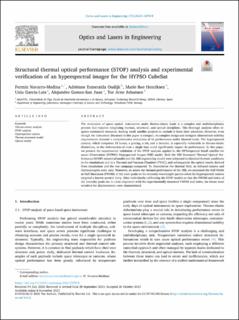| dc.contributor.author | Oudijk, Adriënne Esmeralda | |
| dc.contributor.author | Navarro-Medina, Fermin | |
| dc.contributor.author | Henriksen, Marie Bøe | |
| dc.contributor.author | Garcia-Luis, Uxia | |
| dc.contributor.author | Gomez-San Juan, Alejandro | |
| dc.contributor.author | Johansen, Tor Arne | |
| dc.date.accessioned | 2024-02-08T09:32:58Z | |
| dc.date.available | 2024-02-08T09:32:58Z | |
| dc.date.created | 2024-01-19T13:28:41Z | |
| dc.date.issued | 2023 | |
| dc.identifier.citation | Optics and lasers in engineering. 2023, 173 . | en_US |
| dc.identifier.issn | 0143-8166 | |
| dc.identifier.uri | https://hdl.handle.net/11250/3116315 | |
| dc.description.abstract | The evaluation of space optical instruments under thermo-elastic loads is a complex and multidisciplinary process that requires integrating thermal, structural, and optical disciplines. This thorough analysis often requires substantial resources, leading small satellite projects to exclude it from their schedules. However, even though the instrument discussed in this paper is compact, its complex design and stringent dimensional stability requirements demand a comprehensive evaluation of its performance under thermal loads. The hyperspectral camera, which comprises 18 lenses, a grating, a slit, and a detector, is especially vulnerable to thermo-elastic distortions, as the deformation of even a single lens could significantly impact its performance. In this paper, we present the experimental validation of the STOP analysis applied to the HYPerspectral Small satellite for ocean Observation (HYPSO) Hypespectral Imager (HSI) model. Both the HSI Structural Thermal Optical Performance (STOP) numerical model and the HSI engineering model were subjected to identical thermal conditions in the simulations and in a Thermal and Vacuum Chamber (TVAC), and subsequently the optical results derived from simulations and the test campaign compared. To characterize the thermal field, an infrared camera and thermocouples were used. Moreover, to assess the thermal performance of the HSI, we measured the Full Width at Half Maximum (FWHM) of the main peaks in the intensity-wavelength spectra when the hyperspectral camera targeted a known spectral lamp. After individually calibrating the STOP models so that the FWHM and index of the intensity peaks are in close alignment with the experimentally measured FWHM and index, the lenses most sensitive for displacements were characterized. | en_US |
| dc.language.iso | eng | en_US |
| dc.publisher | Elsevier B. V. | en_US |
| dc.rights | Attribution-NonCommercial-NoDerivatives 4.0 Internasjonal | * |
| dc.rights.uri | http://creativecommons.org/licenses/by-nc-nd/4.0/deed.no | * |
| dc.title | Structural thermal optical performance (STOP) analysis and experimental verification of an hyperspectral imager for the HYPSO CubeSat | en_US |
| dc.title.alternative | Structural thermal optical performance (STOP) analysis and experimental verification of an hyperspectral imager for the HYPSO CubeSat | en_US |
| dc.type | Peer reviewed | en_US |
| dc.type | Journal article | en_US |
| dc.description.version | publishedVersion | en_US |
| dc.source.volume | 173 | en_US |
| dc.source.journal | Optics and lasers in engineering | en_US |
| dc.identifier.doi | https://doi.org/10.1016/j.optlaseng.2023.107919 | |
| dc.identifier.cristin | 2230443 | |
| dc.source.articlenumber | 107919 | en_US |
| cristin.ispublished | true | |
| cristin.fulltext | original | |
| cristin.qualitycode | 1 | |

